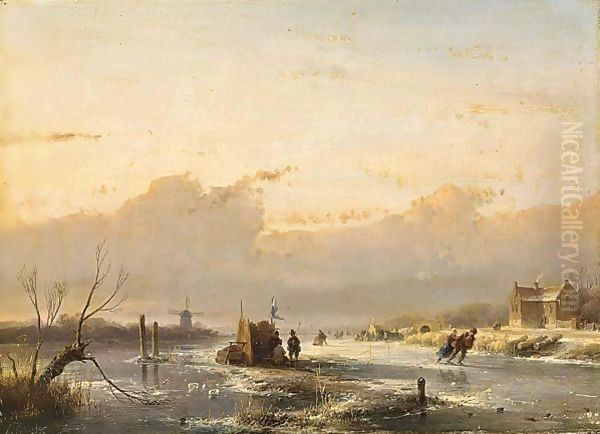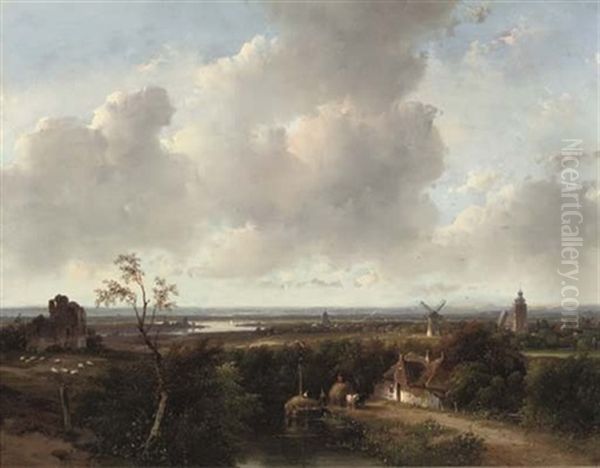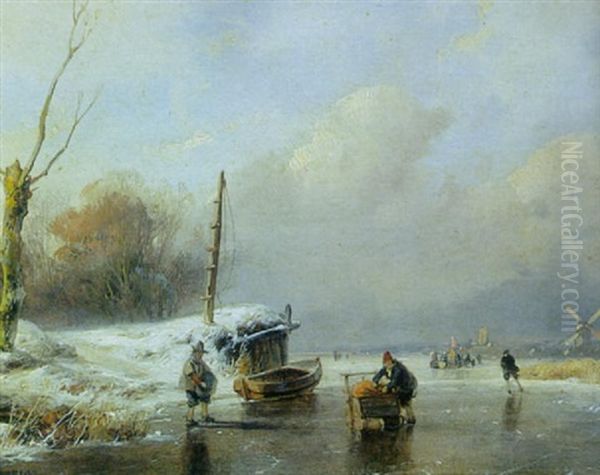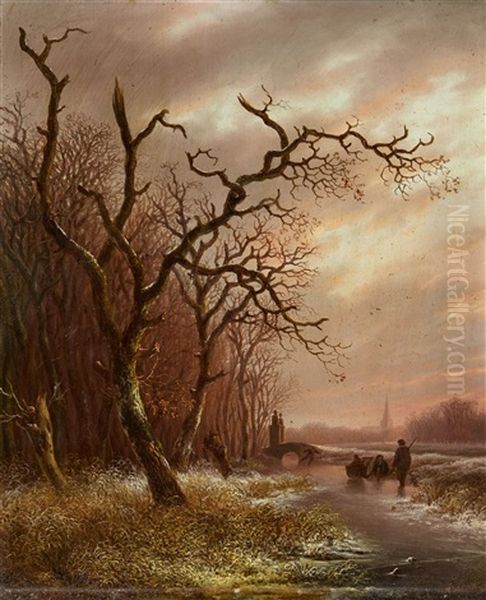
Andreas Schelfhout stands as a pivotal figure in 19th-century Dutch art, celebrated primarily as a landscape painter of the Romantic era. His prolific career spanned several decades, during which he achieved remarkable fame both domestically and internationally, particularly for his evocative and meticulously detailed winter scenes. Born in The Hague on February 16, 1787, and passing away there on April 19, 1870, Schelfhout's life and work bridged the legacy of the Dutch Golden Age landscape tradition with the burgeoning sensibilities of Romanticism, leaving an indelible mark on the generations of artists who followed him. His ability to capture the specific atmosphere and light of the Dutch landscape, especially during winter, earned him widespread admiration and the laudatory nickname, the "Claude Lorrain of the Netherlands."
Early Life and Artistic Formation
Andreas Schelfhout's journey into the art world was not initially straightforward. He was born into a family connected to the arts, albeit more tangentially; his father was a craftsman, working as a carpenter and frame maker. Young Andreas initially followed in his father's footsteps, working in the family's framing business in The Hague. However, his passion lay elsewhere, and he dedicated his spare time to drawing and painting, developing his nascent skills independently.
His talent did not go unnoticed. An early exhibition of his work in The Hague garnered positive attention, which proved decisive. Recognizing his son's potential and dedication, Schelfhout's father facilitated formal artistic training for him. Around 1804 (though some sources suggest slightly later, closer to 1805-1811), he began studying under Joannes Henricus Albertus Antonius Breckenheimer, a respected figure known primarily as a stage designer in The Hague. This apprenticeship was crucial, providing Schelfhout with structured instruction in drawing, perspective, and the fundamentals of painting.

Breckenheimer did more than just teach technique; he guided Schelfhout towards studying the masters of the Dutch Golden Age. Schelfhout immersed himself in the works of 17th-century landscape giants like Meindert Hobbema and Jacob van Ruisdael. Their influence is palpable in his early works, particularly in the detailed rendering of foliage, the structured compositions, and the profound appreciation for the Dutch countryside. This grounding in the national landscape tradition provided a solid foundation upon which he would build his own distinctive style. His early works often depicted summer scenes, coastal views, beaches, and occasionally animals, showcasing his growing technical proficiency.
Rise to Prominence
By 1815, Andreas Schelfhout felt confident enough in his abilities to establish his own independent studio in The Hague. This marked a significant step in his professional career. In the same year, he became a member of the prestigious Pulchri Studio, an artists' society founded in The Hague that played a vital role in the city's cultural life. Membership provided him with opportunities to exhibit his work regularly and interact with fellow artists, further integrating him into the contemporary art scene.
His reputation began to grow steadily. A major breakthrough occurred in 1818 (some sources cite 1819) when he was awarded a Gold Medal at the Exhibition of Living Masters in Antwerp for one of his landscapes. This accolade significantly boosted his visibility and cemented his status as a rising star in the Low Countries. His paintings started attracting serious attention from collectors and critics alike.
While his early repertoire included various landscape themes, Schelfhout increasingly gravitated towards winter scenes. These depictions of frozen canals, snow-covered fields, and skaters enjoying the ice struck a chord with the public and became his signature subject. The combination of technical skill, atmospheric sensitivity, and often charming narrative details in these works proved immensely popular. His fame quickly spread beyond the Netherlands, reaching collectors in France, Great Britain, Germany, and even the Russian Empire, where members of the Imperial family acquired his paintings.
His growing stature was further recognized through official appointments. He became an associate professor (or member) at the Royal Academy of Visual Arts in Amsterdam, a testament to his respected position within the Dutch art establishment. In 1844, his contributions were formally acknowledged when he was appointed a Correspondent, Fourth Class, of the Royal Institute (the precursor to the Royal Netherlands Academy of Arts and Sciences), highlighting his national importance.
The Quintessential Winter Landscapes

It is undeniably Schelfhout's winter landscapes that form the cornerstone of his enduring fame. He possessed an extraordinary ability to capture the unique qualities of the Dutch winter: the crisp air, the specific light reflecting off snow and ice, and the human activities that unfolded in these frozen settings. His paintings often depict bustling scenes on frozen canals or rivers, populated by elegantly rendered figures skating, sledding, or gathering around koek-en-zopie stalls (makeshift stands selling warm drinks and snacks).
Works like Frozen River with Skaters or Winter landscape with skaters and a koek-en-zopie stand exemplify his mastery of this genre. He paid meticulous attention to detail, rendering the texture of the ice – sometimes smooth and reflective, sometimes rough or snow-dusted – with remarkable verisimilitude. The bare branches of trees etched against pale winter skies, the long shadows cast by the low sun, and the subtle gradations of colour in the snow and clouds all contribute to a powerful sense of atmosphere.
His compositions are typically well-balanced, often employing a low horizon line characteristic of Dutch landscape tradition, which gives prominence to the expansive sky. He skillfully used perspective to create a sense of depth, leading the viewer's eye into the scene along the frozen waterway or snow-covered path. The figures in his paintings, though small, are rendered with care and animation, adding life and narrative interest to the landscapes. They are not mere staffage but integral parts of the scene, embodying the Dutch relationship with their winter environment. Schelfhout managed to convey both the harshness and the beauty, the stillness and the liveliness, of winter in the Netherlands.
Style and Technique
Andreas Schelfhout's artistic style is firmly rooted in Dutch Romanticism, yet it represents a unique synthesis of influences. His deep admiration for 17th-century masters like Hobbema and Ruisdael provided a foundation of naturalism and compositional structure. However, he infused this tradition with the heightened emotional sensitivity and appreciation for atmospheric effects characteristic of the Romantic movement. His work is often described as possessing a "romantic poetry."
His technique was marked by fine, precise brushwork, particularly in his earlier periods, allowing for a high degree of detail in rendering textures like wood, ice, and foliage. He had a masterful command of light and shadow (chiaroscuro), using it to define form, create depth, and evoke specific times of day or weather conditions. His colour palettes were generally harmonious and naturalistic, though they could vary depending on the mood he wished to convey – from the cool blues and greys of overcast winter days to the warmer tones of a winter sunset.

Over time, particularly in his later career, Schelfhout's style evolved. Influenced perhaps by travels and exposure to other European art trends, including the work of French artists like Eugène Isabey whom he admired, his brushwork became somewhat looser and more fluid. Some later works exhibit bolder compositional choices, such as the use of strong diagonals to enhance dynamism, and a brighter, more varied colour palette. This evolution shows his willingness to adapt and experiment throughout his long career.
The comparison to the 17th-century French master Claude Lorrain, often invoked during Schelfhout's lifetime, highlights his perceived mastery of atmospheric perspective and idealized landscape composition, albeit translated into a distinctly Dutch context. While Lorrain perfected the Italianate landscape bathed in golden light, Schelfhout achieved a similar level of evocative power within the familiar settings of his homeland, particularly its winter guise. Beyond oil painting, Schelfhout was also proficient in other media, producing watercolours, etchings, and lithographs, further demonstrating his versatile artistic skills.
Beyond Winter: Other Subjects
While most renowned for his winter scenes, Andreas Schelfhout's oeuvre encompassed a broader range of landscape subjects. His early works frequently depicted sunny summer landscapes, featuring lush greenery, tranquil waterways, and rustic buildings. He also painted numerous coastal and beach scenes, capturing the interplay of sand, sea, and sky along the Dutch shores. Works like Fishermen along the Dutch Coast or the auctioned Beach Scene with Boomsluiters (likely depicting traditional flat-bottomed boats) showcase his ability in these genres.
Common elements in his landscapes, regardless of season, include windmills, cottages, churches, and figures engaged in daily rural life or leisure activities. These elements anchor his scenes in the specific reality of the Dutch countryside, adding narrative interest and cultural context. He also documented aspects of modernity entering the landscape, as seen in his painting The Steam Train between The Hague and Leiden, capturing a novel sight within a traditional setting.
Throughout his diverse subjects, Schelfhout maintained a consistent focus on atmospheric effects and the accurate depiction of natural elements. Whether painting the hazy light of a summer morning, the dramatic clouds of a coastal storm, or the clear, cold light of winter, his sensitivity to the nuances of weather and light remained a hallmark of his work. This versatility ensured his appeal to a wide audience and demonstrated the breadth of his talent beyond his celebrated winter specialism.
An Influential Teacher

Andreas Schelfhout's impact on Dutch art extended significantly beyond his own paintings; he was a highly sought-after and influential teacher. He mentored a considerable number of artists in his studio, many of whom went on to achieve considerable success and shape the course of Dutch painting in the later 19th century. His pedagogical approach emphasized direct observation of nature and encouraged students to sketch outdoors (en plein air), capturing the immediate effects of light and atmosphere.
Among his most notable pupils were Johan Barthold Jongkind, Wijnand Nuijen, and Charles Leickert. Jongkind, in particular, is a crucial figure, often considered a forerunner of Impressionism. His time studying with Schelfhout provided him with a strong foundation in landscape painting, which he later developed in a much looser, more light-focused style during his time in France, influencing Impressionists like Claude Monet. Wijnand Nuijen, though his career was tragically short, was another highly talented pupil who embraced Romanticism with a dramatic flair. Charles Leickert became well-known for his cityscapes and winter scenes, clearly showing the influence of his master.
Other students associated with Schelfhout include Julius Jacobus van de Sande Bakhuyzen, known for his pastoral landscapes, Johannes van der Koekkoek (part of the extensive Koekkoek painting dynasty), and Reinhard Kichert (likely referring to Conradijn Cunaeus, known for animal paintings, or perhaps another less famous figure). Through these and other pupils, Schelfhout's emphasis on careful observation, atmospheric rendering, and the Dutch landscape tradition was transmitted to the next generation, ensuring his enduring influence.
Connections and Contemporaries
Andreas Schelfhout operated within a vibrant Dutch art world and maintained connections with many leading artists of his time. He was a contemporary and peer of Barend Cornelis Koekkoek, another giant of Dutch Romantic landscape painting, known especially for his wooded scenes and summer landscapes. Together, Schelfhout and Koekkoek are often seen as the principal figures defining the era's landscape art in the Netherlands. While their styles differed – Koekkoek often favouring more idealized, sometimes German-influenced forest scenes, and Schelfhout excelling in the flat, open Dutch landscapes, especially in winter – they shared a commitment to technical excellence and the Romantic spirit.
Schelfhout was not insular; he engaged with artistic developments beyond the Netherlands. His travels abroad were important for his artistic development. A visit to France in the 1830s exposed him to contemporary French art. A trip to Great Britain around 1833 allowed him to study the works of English landscape painters, notably John Constable. Constable's naturalism and focus on capturing the fleeting effects of weather likely resonated with Schelfhout, even if their styles remained distinct.

Later in his career, his admiration for the French marine and landscape painter Eugène Isabey suggests a continued openness to evolving artistic trends, potentially contributing to the slightly looser handling seen in some of his later works. These interactions and exposures enriched his perspective and ensured his art remained relevant throughout his long career, reflecting both his deep roots in Dutch tradition and his awareness of broader European artistic currents. His membership in societies like Pulchri Studio also facilitated ongoing dialogue and exchange with fellow artists in The Hague.
Recognition and International Acclaim
Throughout his career, Andreas Schelfhout enjoyed consistent recognition and acclaim. His success at the Antwerp exhibition in 1818 was just the beginning. He frequently participated in the 'Exhibitions of Living Masters' (Tentoonstelling van Levende Meesters) held periodically in Dutch cities like Amsterdam and The Hague, often winning awards and securing sales. His appointment as a member of the Royal Academy in Amsterdam and later as a Correspondent of the Royal Institute underscored his esteemed position within the official art establishment.
His popularity extended far beyond the borders of the Netherlands and Belgium. Collectors across Europe sought out his work. His winter landscapes, in particular, seemed to capture a quintessential Dutch charm that appealed internationally. As mentioned, his paintings entered collections in Great Britain, France, Germany, and notably Russia, where the Tsars were known to appreciate Dutch art. This international demand contributed significantly to his financial success and widespread fame.
The nickname "Claude Lorrain of the Netherlands," while perhaps simplifying the nuances of his style, speaks volumes about the high regard in which he was held. It placed him in the lineage of the great European landscape masters, acknowledging his technical skill, compositional harmony, and ability to evoke mood and atmosphere. His works were seen as embodying the best qualities of contemporary Dutch landscape painting, rooted in tradition yet infused with a modern Romantic sensibility.
Market Presence and Collections
The enduring appeal of Andreas Schelfhout's work is reflected in its continued presence in the art market and in prestigious collections. Throughout the 20th and 21st centuries, his paintings have regularly appeared at auction houses like Christie's and Sotheby's, as well as regional European auctioneers like Lempertz in Germany and various Dutch firms. Auction records show consistent demand, particularly for his signature winter scenes featuring skaters.

While prices vary depending on size, quality, condition, and subject matter, significant examples of his work command substantial sums. Auction results from the early 2000s, such as Beach Scene with Boomsluiters (Christie's Amsterdam, 2001) and Sunlight on the Ice (Kunsthandel Pieter A. Scheen, 2004), indicate steady interest. Works handled by dealers like Simonis & Buunk and Kunsthandel Borzo further attest to his market presence. Even minor works or studies can achieve respectable prices, demonstrating the breadth of collector interest.
Today, Schelfhout's paintings are held in numerous major public collections, primarily in the Netherlands and Belgium. Key institutions include the Rijksmuseum in Amsterdam, the Kunstmuseum Den Haag (formerly Gemeentemuseum), the Teylers Museum in Haarlem, and the Royal Museums of Fine Arts of Belgium in Brussels. His work can also be found in museums elsewhere in Europe, such as the Luxembourg City Museum, which holds the aforementioned Winter landscape with skaters and a koek-en-zopie stand. Numerous works also remain in private collections worldwide, a testament to his widespread popularity during his lifetime and beyond.
Legacy and Enduring Appeal
Andreas Schelfhout died in The Hague in 1870, concluding a long and remarkably successful career. His legacy is multifaceted. As a painter, he perfected the Dutch winter landscape, creating images that have become iconic representations of the Netherlands in the 19th century. He skillfully blended the detailed naturalism inherited from the Golden Age with the atmospheric sensitivity and emotional depth of Romanticism. His technical mastery, particularly in rendering light, ice, and sky, remains impressive.
His influence as a teacher was profound. Through pupils like Jongkind, Nuijen, and Leickert, his approach to landscape painting, emphasizing direct observation and atmospheric truthfulness, contributed significantly to the evolution of Dutch art, paving the way for later movements like The Hague School and even providing foundational elements for Impressionism via Jongkind. He thus serves as a crucial link between the historical traditions of Dutch art and its modern developments.
While some later critics might have found his prolific output occasionally repetitive, his best works retain their freshness and evocative power. They offer a compelling vision of the Dutch landscape, imbued with a sense of place, time, and human presence. Andreas Schelfhout remains a cornerstone figure in 19th-century Dutch art history, a master technician, an influential educator, and the creator of some of the most beloved and enduring images of the Netherlands. His paintings continue to be admired for their beauty, skill, and quintessential Dutch character.